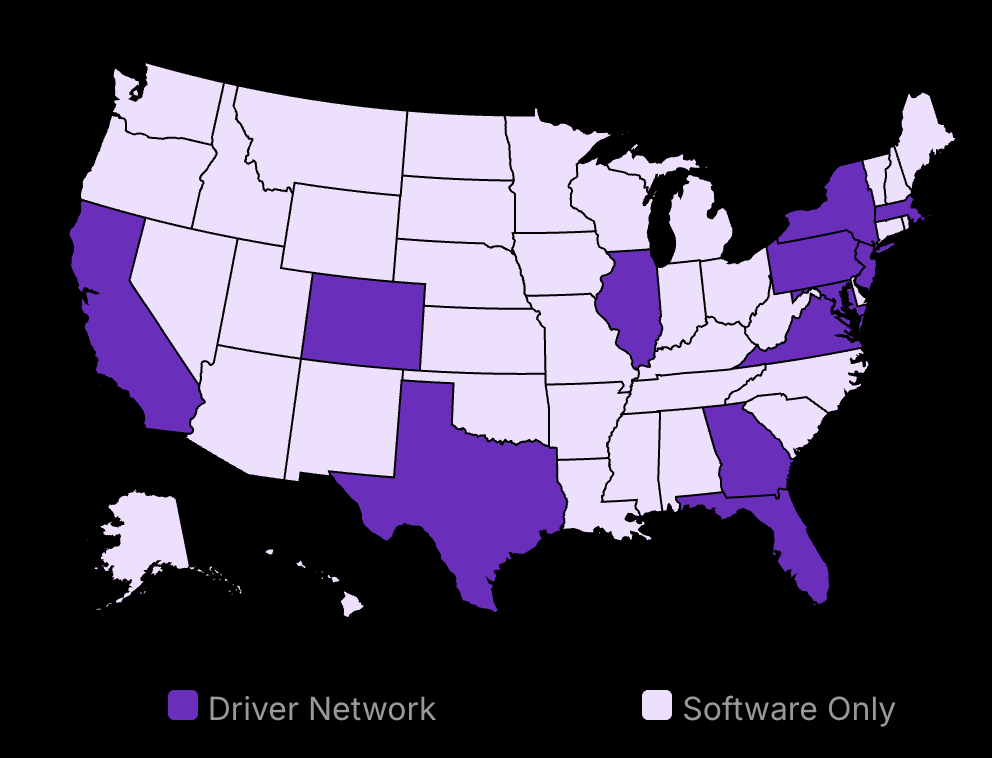Running a business with a fleet vehicle leasing is like holding two bank accounts. One drains with every new car purchase. The other stays healthy with smart fleet leasing. In 2025, this difference matters more than ever.
Fleet leasing isn’t just for big companies anymore. Small businesses across the US are discovering they can access better vehicles without the financial headache of ownership. But the decision isn’t simple—it’s about finding the right financial structure for your specific fleet needs.
Consider this: a local delivery service saved $78,000 in its first year after switching from ownership to leasing its 12-vehicle fleet. The money they didn’t spend on maintenance and depreciation went straight to hiring three new employees.
The management landscape has changed. Electric vehicles now make up 37% of new commercial fleet leases. Telematics systems track everything from fuel efficiency to driver behavior. And the financial models have evolved to match different business cycles.
But which option is right for your business? Should you choose an open-end lease with its flexibility but higher risk? Or is a closed-end lease with predictable costs but stricter terms the better choice?
This guide breaks down the full spectrum of fleet leasing options available in 2025. We’ll examine the financial implications, operational benefits, and potential pitfalls of each approach. You’ll learn exactly how to assess your business needs and select the leasing structure that maximizes your resources, ensuring you have all the information you need .
Whether you’re managing five vehicles or fifty, the right leasing strategy can transform your fleet from a financial burden into a business advantage.

Save 80% of delivery management time
We handle everything:
- Dedicated operations manager
- Real-time tracking dashboard
- Automated customer notifications
- Urgent issue resolution
What is Fleet Leasing?
Fleet leasing lets businesses rent multiple vehicles with monthly payments instead of buying them outright
Contracts typically include maintenance, insurance, and service arrangements
Two main types exist: open-end (flexible but with residual value risk) and closed-end (fixed terms but more predictable costs)
Fleet leasing is a business arrangement where a company rents multiple vehicles from a leasing company for a set period instead of purchasing them. The business pays regular monthly payments to use the vehicles, which are returned to the leasing company when the contract ends. This model gives businesses access to vehicles without the large capital investment of buying them outright. Understanding what exactly constitutes a fleet vehicle is crucial when considering fleet leasing options. A fleet vehicle generally refers to any motor vehicle owned or leased by a business for commercial purposes rather than personal use. These vehicles can range from cars and vans to trucks and specialty vehicles, each tailored to meet various operational needs. To gain a deeper insight into the types of fleet vehicles and whether your business should utilize one, check out this detailed explanation on the features and benefits of a fleet vehicle.
In a standard fleet lease agreement, the leasing company maintains ownership of the vehicles while the business gets full use of them for the duration of the contract. The monthly payment covers the vehicle’s depreciation during the lease term, plus interest charges and often includes additional services. Lease terms typically range from long term leases of 24 to 60 months, with most businesses opting for 36 or 48-month terms to balance cost with vehicle reliability.
What makes fleet leasing different from regular car leasing is the scale and the business-focused services included. Fleet leases often cover multiple vehicles and can include comprehensive packages for maintenance, insurance, registration, roadside assistance, and fuel management. These services help businesses avoid the administrative burden of managing these aspects themselves.
Example(s) of Fleet Leasing
A nationwide delivery service with 500 vans demonstrates how fleet leasing works in practice. Rather than investing $15 million upfront to purchase their vehicles, they chose a 48-month closed-end lease. Their monthly payment of $625 per vehicle includes maintenance, roadside assistance, and replacement vehicles during service periods. This arrangement allowed them to keep $15 million in working capital for core business operations while maintaining a modern, reliable delivery fleet.
The company experienced several tangible benefits from this decision. First, they avoided taking on debt to purchase vehicles, keeping their balance sheet stronger. Second, they reduced their management staff from six to two employees, as the leasing company handled most maintenance scheduling and logistics. Finally, they gained access to the leasing company’s fleet management software, which helped in effectively managing routes and reducing fuel consumption by 12% compared to their previous operations.
Another example comes from a mid-sized regional sales company with 75 vehicles. They chose an open-end lease for their truck sales fleet because their representatives drive varying distances. The flexible mileage terms allow high-performing sales representatives to cover larger territories without penalty, while still providing predictable monthly costs. When they switched from ownership to leasing, they reduced their annual vehicle-related expenses by 22% and improved employee satisfaction by providing newer vehicles with better technology and safety features.
Types of Fleet Leasing
Fleet leasing comes in two primary forms, each designed to address different business needs and risk preferences. The choice between these options can significantly impact a company’s financial obligations, operational flexibility, and long-term vehicle management strategy.
Open-end and closed-end leases differ mainly in who bears the risk of the vehicle’s value at the end of the lease term. With an open-end lease, the business accepts this risk, while in a closed-end lease, the leasing company assumes it. This fundamental difference creates cascading effects on contract terms, flexibility, and cost structure that make each option suitable for different situations.
Most fleet leasing companies offer both types and can help businesses determine which option aligns best with their specific needs. The right choice depends on factors including mileage expectations, vehicle wear patterns, length of service needed, and the company’s preference for either flexibility or predictability in their fleet operations.
Type 1: Open-End Leases For Fleet Needs
Open-end leases provide businesses with more flexibility but come with greater financial responsibility at the end of the lease term. In this arrangement, the business agrees to pay the difference between the predetermined residual value and the actual market value when the vehicle is sold at lease end. This structure means the business bears the risk of vehicle depreciation.
The monthly payments in open-end leases are typically lower than closed-end leases because the leasing company isn’t building in protection against residual value risk. However, if vehicles are driven more miles than expected or experience unusual wear, the business may face substantial end-of-lease payments. This makes open-end leases better suited for companies that:
Have unpredictable or high-mileage requirements
Keep vehicles for longer periods (often 4+ years)
Want to avoid mileage restrictions
Need flexibility to extend lease terms as business needs change
Have the financial capability to handle variable end-of-lease costs
The financial structure of open-end leases also provides accounting benefits. Because the business commits to paying the vehicle’s full depreciation, these leases can often be structured as capital leases for accounting purposes, allowing companies to claim depreciation on their tax returns similar to vehicle ownership.
Type 2: Closed-End Leases
Closed-end leases offer businesses more predictable costs with less risk at lease termination. In this arrangement, the leasing company takes on the residual value risk, meaning the business can simply return the vehicle at lease end with no additional financial obligation as long as the vehicle meets the return conditions specified in the contract.
The trade-off for this predictability comes in the form of more structured terms. Closed-end leases typically include:
Set mileage limits (often 12,000-15,000 miles annually)
Specific lease durations that cannot easily be extended
Detailed return condition requirements
Higher monthly payments compared to open-end leases
These leases work best for businesses with predictable vehicle usage patterns. A delivery company that knows its vehicles will travel approximately 12,000 miles annually on city routes can accurately predict wear and stay within lease parameters. The higher monthly payment essentially serves as insurance against residual value fluctuations.
From an accounting perspective, closed-end leases typically qualify as operating leases, allowing businesses to expense the entire monthly payment rather than dealing with depreciation schedules. This simplifies accounting and can be advantageous for businesses looking to minimize balance sheet liabilities.
Benefits of Fleet Leasing for Businesses
Fleet leasing reduces capital expenditure while providing access to new vehicles
Companies gain financial flexibility with predictable monthly payments
Businesses can focus on core operations while leasing companies handle vehicle management
Improved Cash Flow
Fleet leasing fundamentally changes how businesses manage their transportation resources. Instead of making large upfront payments to purchase vehicles, companies can preserve cash by making smaller, predictable monthly payments. This shift from capital expenditure (CapEx) to operational expenditure (OpEx) creates significant financial advantages.
When a business purchases a fleet of vehicles, it might spend hundreds of thousands or even millions of dollars at once. This large cash outflow can limit funds available for other business opportunities, making fleet leasing a way to save money. According to recent market data, the global automotive fleet leasing market was valued at US$27.7 billion in 2024 and is projected to reach US$35.2 billion by 2030, growing at a CAGR of 4.1%, showing how many businesses are choosing this cash flow-friendly option.
The predictability of lease payments also helps with budgeting. Finance departments can plan with greater certainty when vehicle costs are fixed monthly expenses rather than variable costs that include unexpected repairs or maintenance. This predictability extends to the entire lease term, which typically ranges from 24 to 60 months, depending on the agreement.
Tax Benefits and Balance Sheet Improvements
Leasing can offer tax advantages that purchasing cannot. Lease payments are generally tax-deductible as business expenses, while purchased vehicles may only allow for depreciation deductions over a longer period. This can result in lower taxable income in the short term.
Additionally, leased vehicles may not appear as assets on a company’s balance sheet (depending on the lease structure and accounting standards). This can improve certain financial ratios that investors and lenders use to evaluate business performance, potentially making it easier to secure financing for other business needs.
Access to Newer Vehicle Models
One of the most practical benefits of fleet leasing is the ability to regularly update vehicles. Most lease agreements last 2-4 years, allowing businesses to refresh their fleets with new models featuring the latest technology and safety features without the hassle of selling used vehicles. For businesses aiming to streamline delivery operations, adopting best practices can optimize the benefits of fleet leasing. Implementing strategies like route optimization, driver performance monitoring, and vehicle maintenance scheduling ensures maximum efficiency. To deepen your understanding and improve fleet operations, explore expert advice in this detailed guide on effective fleet management techniques.
Moreover, integrating advanced fleet management solutions can significantly elevate the operational efficiency of your leased vehicles. Techniques such as analytics-driven route planning, real-time vehicle diagnostics, and proactive maintenance scheduling not only reduce downtime but also enhance driver safety and customer satisfaction. Businesses that leverage these fleet management strategies position themselves to capitalize on the full advantages of their leasing agreements while minimizing operational costs.
Newer vehicles typically include advanced fuel efficiency technologies, which directly impact operational costs. A fleet of vehicles with better fuel economy can save thousands of dollars annually in fuel expenses. For example, a business with 50 vehicles that each save just $30 per month in fuel costs would realize annual savings of $18,000 – a significant amount that goes straight to the bottom line.
Modern vehicles also come equipped with enhanced safety features like automatic emergency braking, lane departure warnings, and blind-spot monitoring. These technologies not only protect employees but can also reduce accident rates and associated costs, including insurance premiums, vehicle repairs, and potential liability claims.
Technology Integration and Brand Image
New vehicles often include integrated telematics and connectivity features that support fleet leasing management systems. These technologies enable businesses to track vehicle locations, monitor driver behavior, and optimize routes, all contributing to operational efficiency.
The appearance of company vehicles also affects brand perception. When clients and customers see employees arriving in new, well-maintained vehicles, it creates a positive impression of the company’s professionalism and success. This subtle marketing benefit is difficult to quantify but can influence business relationships and customer trust.
Reduced Administrative Burden
Fleet leasing agreements often include comprehensive fleet management services that handle many time-consuming tasks related to vehicle ownership. This package of services can dramatically reduce the administrative load on a company’s staff.
Most leasing providers offer maintenance programs that schedule regular service appointments, track service history, and ensure that manufacturer warranties remain valid. This centralized approach to maintenance helps prevent small issues from becoming major problems and extends vehicle lifespans.
Insurance management is another valuable service included in many fleet leasing packages. The leasing company can negotiate favorable rates with insurers based on its large volume of business and manage claims when accidents occur. This removes a significant administrative task from the client company’s to-do list.
Registration renewals, compliance with transportation regulations, and other paperwork are typically handled by the leasing company as well. For businesses operating across multiple states or countries, this service alone can save countless hours of administrative work and help avoid penalties for missed deadlines or requirements.
Fleet Flexibility and Scalability
Businesses rarely maintain the same size and scope indefinitely. As companies grow, contract, or shift their operational focus, their vehicle needs change as well. Fleet leasing offers built-in flexibility that owned vehicles cannot match.
During periods of growth, adding vehicles to a leased fleet is straightforward. Companies can quickly secure additional vehicles without significant capital outlays, allowing them to respond rapidly to new business opportunities. This scalability is particularly valuable for seasonal businesses or those with fluctuating demand.
Conversely, when a business needs to downsize, lease agreements often include provisions for early termination or vehicle returns, though some fees may apply. This is still typically less costly and complicated than selling owned vehicles during a contraction period, especially when vehicle markets are unfavorable.
Adapting to Market and Technology Changes
The business environment changes rapidly, and fleet leasing allows companies to adapt their vehicle strategies accordingly. If fuel prices rise dramatically, a business with a leased fleet can transition to more fuel-efficient models at the end of their lease terms rather than being stuck with owned vehicles that have become expensive to operate.
Similarly, as electric and hybrid vehicles become more practical for business use, leasing makes it easier to incorporate these technologies into a company’s fleet without committing to ownership of vehicles that use relatively new technology. The ability to “test” new vehicle types through leasing rather than purchasing provides valuable flexibility as automotive technology evolves.
Risk Mitigation and Residual Value Protection
Perhaps one of the most underappreciated benefits of fleet leasing is the transfer of risk from the business to the leasing company, particularly regarding vehicle depreciation and residual value.
When a business purchases vehicles, it assumes all the risk of depreciation. If market conditions change or certain models lose value more quickly than anticipated, the company absorbs that loss when selling or trading in the vehicles. Closed-end lease agreements shift this risk to the leasing company, which sets the residual value at the beginning of the lease term.
For businesses using company vehicles in client-facing roles, leasing reduces the risk associated with vehicle damage or excessive wear. While lease agreements include provisions for unusual damage, normal wear and tear are expected and built into the lease cost. This provides greater certainty about the total cost of vehicle operations over the lease term.
Protection Against Technological Obsolescence
As automotive technology advances rapidly, the risk of owning vehicles that become technologically outdated increases. This is particularly true with the current transition toward electric vehicles and autonomous driving features. Leasing allows businesses to avoid investing in technology that may become obsolete before the vehicle reaches the end of its useful life.
Many fleet leasing management experts suggest that during periods of significant technological transition in the automotive industry, leasing provides a hedge against making large investments in soon-to-be-outdated technology. This perspective is particularly relevant now, as the industry undergoes its most significant transformation since the introduction of the assembly line.
How Fleet Leasing Works for Businesses
For businesses considering fleet leasing, understanding the basic process helps in making informed decisions. Most business leases start with an assessment of needs, including the number of vehicles, types, expected mileage, and desired features.
The leasing company then provides a quote based on these requirements, typically including the monthly payment amount, lease term, included services, and end-of-lease conditions. After agreeing to terms, the business makes a small down payment (often just the first month’s payment) and receives the vehicles.
LLC Vehicle Leasing Considerations
Many small business owners wonder about leasing vehicles through their LLC. This arrangement offers several advantages, including liability protection and potential tax benefits. When a vehicle is leased through an LLC rather than personally, the business structure helps shield personal assets from claims related to accidents or incidents involving the leased vehicles.
From a tax perspective, vehicles leased through an LLC can often be fully deducted as business expenses if they’re used exclusively for business purposes. If there’s personal use, the business can only deduct the percentage of costs related to business use. Business owners should consult with tax professionals to ensure they’re maximizing deductions while staying compliant with tax laws.
For growing businesses, leasing through an LLC also establishes a commercial credit history for the business entity separate from the owner’s credit. This separation becomes increasingly important as the business expands and seeks additional financing or leasing arrangements.
Fleet Leasing vs. Ownership
Leasing eases cash flow with lower monthly payments and tax benefits.
Ownership offers freedom from mileage limits and potential asset resale.
Leasing adapts easily to business changes, while ownership is financially intensive.
Financial Differences
When weighing the financial aspects of leasing against ownership, several critical differences stand out. Leasing usually involves lower monthly payments because payments cover only the vehicle’s depreciation, not its full price. Additionally, upfront costs for leasing are usually just a deposit, making it less financially burdensome initially. In contrast, purchasing vehicles demands a higher initial expenditure, primarily affecting businesses with limited capital. But, long-term ownership may benefit businesses with stable routes, a high vehicle utilization rate, and the financial strength to withstand the initial investment, especially since they hold the liberty to later sell the vehicles.
From a tax perspective, lease payments can be deducted as business expenses. On the other hand, owners can deduct depreciation and loan interest. It’s essential to consider how leasing often includes maintenance costs, alleviating the burden from the business.
Operational Flexibility
Leasing stands out in offering operational flexibility. Companies leasing their fleet can upgrade to newer models as needed, an attractive feature for fast-paced businesses that must adapt to technological and regulatory changes. This adaptability ensures fleets are aligned with the latest standards and efficiency benchmarks, helping businesses cut costs. Hence, leasing becomes particularly compelling for businesses prioritizing efficiency and the swift implementation of technological advances.
Owned fleets lack this agility as the commitment extends until the vehicles are either sold or disposed of. Businesses with owned vehicles often face a trade-off between capital locked in depreciating assets and the flexibility needed to keep operations nimble. Another consideration of leasing is mileage limitations. Leased vehicles come with clear mileage restrictions that, if exceeded, incur additional costs. In pursuit of limitless business operations, ownership frees companies from these limitations, enabling higher operational flexibility without added charges.
General Considerations
Addressing the common question, “Is it better to buy or lease vehicles?” depends heavily on a company’s specific needs and strategic goals. Leasing generally provides more immediate financial relief and flexibility, ideal for businesses rapidly scaling or adapting. Ownership comes without mileage constraints and allows for complete vehicle customization. However, it ties up significant capital and requires a more substantial financial commitment at the onset, potentially constraining other operational areas.
For those considering the secondary market, fleet lease vehicles can be good buys since they are often well-maintained and relatively new. Yet, most companies must weigh potential costs, like repairs and insurance rates, noting that vehicles can sometimes carry higher insurance premiums due to varied driving history and usage patterns. Further, the disadvantages of fleet leasing must be considered, including the contractual rigidity and the possibility of penalties for violations or early termination. The life expectancy of vehicles often matches or exceeds expectations due to rigorous maintenance schedules typical of leased fleets.
Trends in Fleet Management for 2025
Shift towards electric vehicles in fleet leasing.
Rise in telematics for fleet efficiency.
Rise of Electric Vehicle Leasing
In the past year, the world has witnessed a huge rise in electric vehicle (EV) adoption in fleet leasing. A clear driver is the intensified focus on reducing carbon footprints. Throughout 2024, several key players in the automotive industry expanded their EV offerings. For instance, in January, Ford introduced more electric models specifically targeting lease options for fleets. By March, General Motors announced partnerships with several leasing companies, smoothing the entry for businesses seeking electric fleets.
By mid-year, many companies pivoted to leasing models to bypass the hefty upfront costs of purchasing EVs. This trend didn’t slow down. By October 2024, 30% of new fleet leases in Europe were electric. This was encouraged by governmental incentives pushing greener transport solutions.
For the next year, expect even more options, driven by innovations in battery technology. Businesses should be ready to transition to electric options. This will not only be environmentally savvy but also generally cost-effective in terms of fuel and maintenance. It will be smart for companies to begin evaluating their infrastructure now. Charging stations and other facilities should be on the agenda to keep pace with this shift.
Telematics in Fleet Management
Telematics has revolutionized fleet management recently. This technology, which involves tracking and data analysis, started gaining ground in the first quarter of 2024. Early in the year, several top fleet management firms adopted telematics solutions to enhance operational efficiency. By April, fleets began using telematics to optimize routes and reduce fuel consumption. Real-time data provided insights into driver behavior, helping improve safety and efficiency across fleets.
As summer approached, more businesses integrated telematics into their daily operations. By July, several pilot programs were launched, integrating telematics with policy-driven metrics to promote safety and environmental responsibility. By the end of the year, a 20% increase in fleet efficiency was observed among companies that fully integrated telematics.
Looking ahead, the integration of artificial intelligence with telematics is expected to revolutionize fleet management even further. Predictive analytics will aid in maintenance scheduling, reducing downtime. It will be crucial for businesses to stay ahead by investing in these technologies early. This is not just about staying competitive; it is about ensuring ongoing improvements in fleet efficiency and safety.
Fleet Operation For Business Needs
You now have a comprehensive understanding of how fleet leasing works, especially beneficial for businesses in 2025. From comparing open-end and closed-end leases to assessing the financial and operational impacts, we’ve covered a lot. Fleet leasing isn’t just a financial choice; it’s a strategic tool. It offers flexibility, improved cash flow, and ongoing access to new vehicle models and technology, transforming how businesses manage their transportation needs. Maximizing the benefits of fleet leasing goes beyond choosing the right vehicles—it requires effective management of those assets to truly save time and money. Implementing proven fleet optimization techniques can streamline operations, improve route efficiency, and reduce unnecessary expenses. These strategies empower businesses to leverage their leased fleets fully, ensuring every mile traveled contributes positively to the bottom line.
The rise of electric vehicle leases and telematics in fleet management hints at an exciting future. These innovations promise not just better efficiency but also an opportunity to align with sustainability goals. So, consider how fleet leasing aligns with your own business goals. To further enhance your understanding and improve operational efficiency, exploring comprehensive Fleet Optimization strategies is essential. These strategies focus on saving both time and money by streamlining vehicle use, improving route planning, and reducing maintenance costs. Adopting such approaches will complement your fleet leasing decisions and maximize your investment.
Implementing effective fleet optimization is crucial to fully leverage the advantages of fleet leasing. Businesses that incorporate advanced management techniques can significantly cut operational costs and improve vehicle utilization. For more in-depth insights and actionable methods, check out our detailed external post on streamlined fleet optimization strategies designed to save your company both time and money.
The decision to lease involves careful consideration, but with the right approach, fleet leasing can be more than just a choice—it’s a pathway to streamlined operations and enhanced business agility. Your next step? Evaluate your business needs and start exploring the fleet leasing options that best fit your company. The knowledge you’ve gained today sets the foundation for informed decisions and better outcomes. The road to smarter fleet management starts here. Are you ready to take the wheel?




























